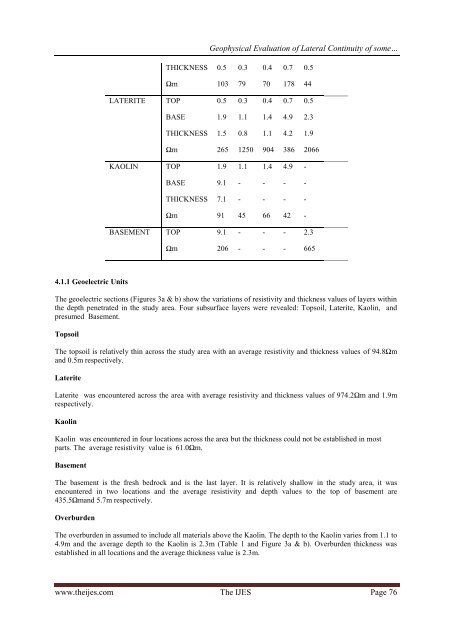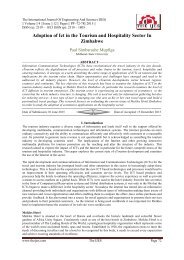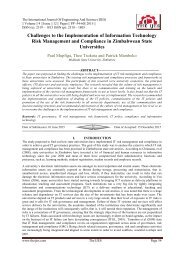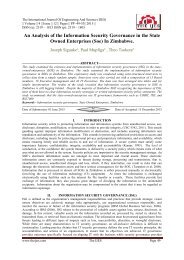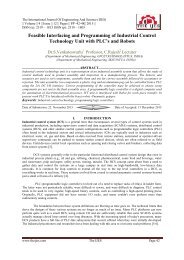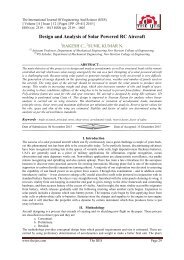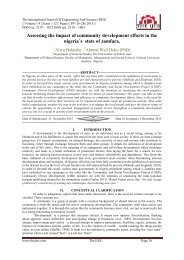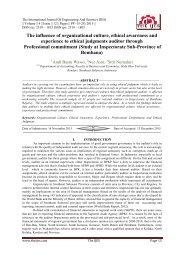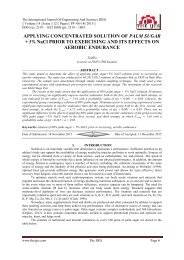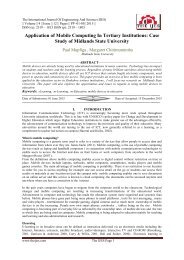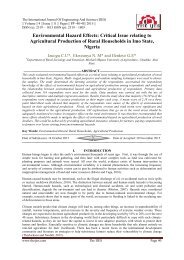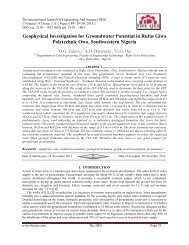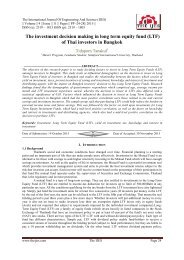Geophysical Evaluation of Lateral Continuity of some part of Ikere Kaolin Deposit, Southwestern Nigeria
The International Journal of Engineering & Science is aimed at providing a platform for researchers, engineers, scientists, or educators to publish their original research results, to exchange new ideas, to disseminate information in innovative designs, engineering experiences and technological skills. It is also the Journal's objective to promote engineering and technology education. All papers submitted to the Journal will be blind peer-reviewed. Only original articles will be published. The papers for publication in The International Journal of Engineering& Science are selected through rigorous peer reviews to ensure originality, timeliness, relevance, and readability.
The International Journal of Engineering & Science is aimed at providing a platform for researchers, engineers, scientists, or educators to publish their original research results, to exchange new ideas, to disseminate information in innovative designs, engineering experiences and technological skills. It is also the Journal's objective to promote engineering and technology education. All papers submitted to the Journal will be blind peer-reviewed. Only original articles will be published.
The papers for publication in The International Journal of Engineering& Science are selected through rigorous peer reviews to ensure originality, timeliness, relevance, and readability.
Create successful ePaper yourself
Turn your PDF publications into a flip-book with our unique Google optimized e-Paper software.
<strong>Geophysical</strong> <strong>Evaluation</strong> <strong>of</strong> <strong>Lateral</strong> <strong>Continuity</strong> <strong>of</strong> <strong>some</strong>…<br />
THICKNESS 0.5 0.3 0.4 0.7 0.5<br />
Ωm 103 79 70 178 44<br />
LATERITE TOP 0.5 0.3 0.4 0.7 0.5<br />
BASE 1.9 1.1 1.4 4.9 2.3<br />
THICKNESS 1.5 0.8 1.1 4.2 1.9<br />
Ωm 265 1250 904 386 2066<br />
KAOLIN TOP 1.9 1.1 1.4 4.9 -<br />
BASE 9.1 - - - -<br />
THICKNESS 7.1 - - - -<br />
Ωm 91 45 66 42 -<br />
BASEMENT TOP 9.1 - - - 2.3<br />
Ωm 206 - - - 665<br />
4.1.1 Geoelectric Units<br />
The geoelectric sections (Figures 3a & b) show the variations <strong>of</strong> resistivity and thickness values <strong>of</strong> layers within<br />
the depth penetrated in the study area. Four subsurface layers were revealed: Topsoil, Laterite, <strong>Kaolin</strong>, and<br />
presumed Basement.<br />
Topsoil<br />
The topsoil is relatively thin across the study area with an average resistivity and thickness values <strong>of</strong> 94.8Ωm<br />
and 0.5m respectively.<br />
Laterite<br />
Laterite was encountered across the area with average resistivity and thickness values <strong>of</strong> 974.2Ωm and 1.9m<br />
respectively.<br />
<strong>Kaolin</strong><br />
<strong>Kaolin</strong> was encountered in four locations across the area but the thickness could not be established in most<br />
<strong>part</strong>s. The average resistivity value is 61.0Ωm.<br />
Basement<br />
The basement is the fresh bedrock and is the last layer. It is relatively shallow in the study area, it was<br />
encountered in two locations and the average resistivity and depth values to the top <strong>of</strong> basement are<br />
435.5Ωmand 5.7m respectively.<br />
Overburden<br />
The overburden in assumed to include all materials above the <strong>Kaolin</strong>. The depth to the <strong>Kaolin</strong> varies from 1.1 to<br />
4.9m and the average depth to the <strong>Kaolin</strong> is 2.3m (Table 1 and Figure 3a & b). Overburden thickness was<br />
established in all locations and the average thickness value is 2.3m.<br />
www.theijes.com The IJES Page 76


